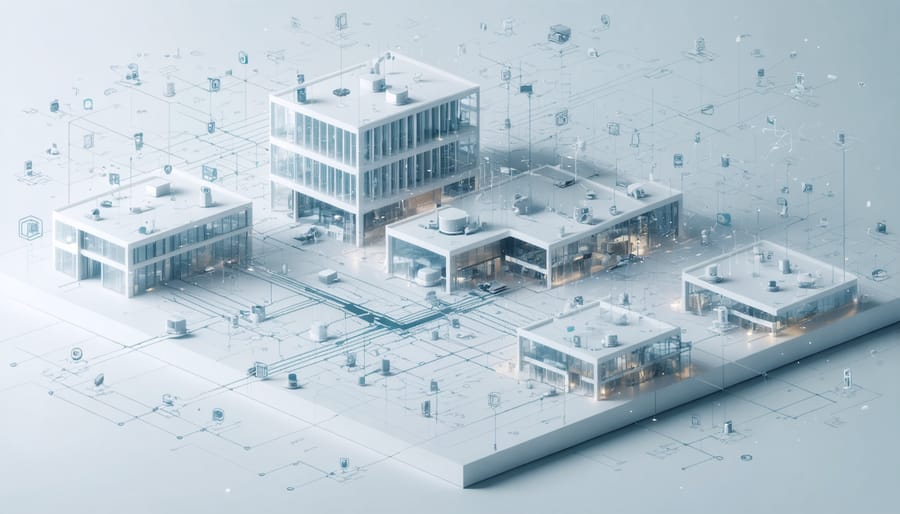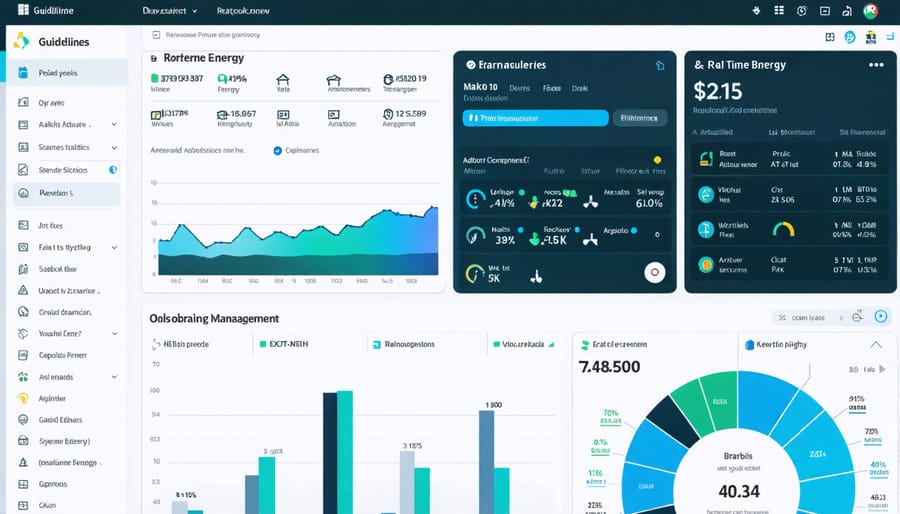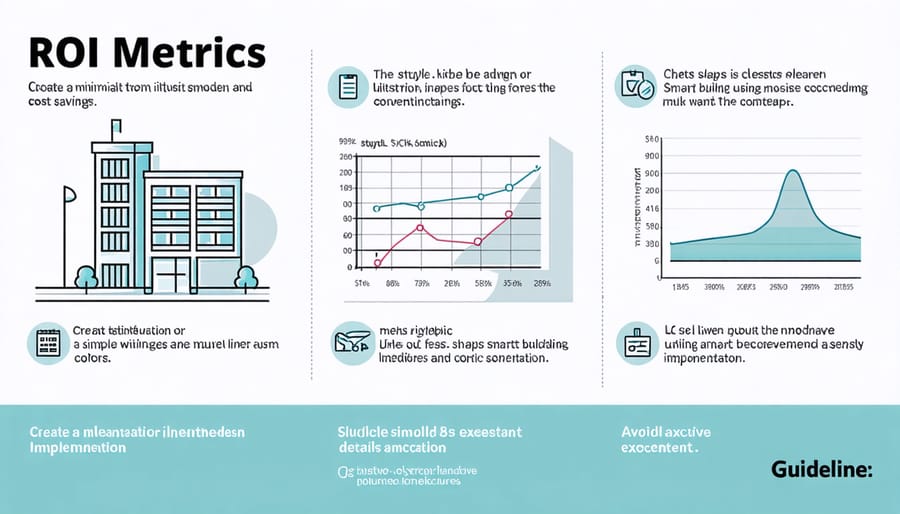Smart building systems represent a transformative leap in modern construction, integrating smart building technology with advanced automation to revolutionize how structures operate, consume energy, and serve their occupants. These intelligent ecosystems leverage IoT sensors, artificial intelligence, and real-time analytics to create buildings that actively respond to environmental conditions, occupancy patterns, and operational demands. By connecting HVAC, lighting, security, and facility management systems through a centralized platform, smart buildings deliver unprecedented levels of efficiency, reducing energy consumption by up to 40% while enhancing occupant comfort and productivity. For construction professionals and facility managers, this integration represents not just an technological upgrade, but a fundamental shift in how buildings are designed, constructed, and maintained for optimal performance throughout their lifecycle. The convergence of digital innovation and traditional building systems creates opportunities for predictive maintenance, dynamic resource allocation, and data-driven decision-making that directly impacts both operational costs and environmental sustainability.
The Core Components of Smart Building Energy Management
Sensor Networks and IoT Integration
Sensor networks form the foundation of smart building systems, acting as the nervous system that continuously monitors and reports on building conditions. These networks typically comprise various sensor types, including occupancy sensors, temperature monitors, air quality detectors, and lighting level meters, all working in concert to provide real-time data streams.
Modern building sensors utilize advanced IoT protocols such as BLE (Bluetooth Low Energy), ZigBee, and LoRaWAN to establish robust communication networks. These protocols enable sensors to transmit data efficiently while minimizing power consumption, with many devices operating for years on single battery installations.
The integration of these sensor networks with IoT platforms creates a comprehensive building management ecosystem. Gateway devices collect data from multiple sensors and transmit it to cloud-based management systems, where advanced analytics processes transform raw data into actionable insights. This infrastructure enables features such as predictive maintenance, automated climate control, and dynamic space utilization.
Security considerations are paramount in sensor network design, with encryption and authentication protocols protecting both data transmission and storage. Modern systems implement end-to-end encryption and regular security updates to protect against potential vulnerabilities.
The scalability of these networks allows for gradual implementation, starting with critical areas and expanding as needed. This approach enables building managers to optimize their investment while maintaining system reliability and performance across the entire infrastructure.

Building Management Systems (BMS)
Building Management Systems (BMS) serve as the central nervous system of smart buildings, integrating and controlling various building operations through a unified platform. These sophisticated systems monitor and manage critical functions including HVAC, lighting, security, fire safety, and energy distribution across the facility.
At their core, BMS platforms utilize advanced automation algorithms and real-time data analytics to optimize building performance. They collect information through a network of sensors and IoT devices, processing this data to make intelligent decisions about facility operations. For instance, a modern BMS can automatically adjust HVAC settings based on occupancy patterns, weather conditions, and energy pricing variables.
The functionality of BMS extends beyond basic automation. These systems provide facility managers with comprehensive dashboards for monitoring performance metrics, generating detailed reports, and implementing preventive maintenance schedules. Through predictive analytics, BMS can identify potential equipment failures before they occur, reducing downtime and maintenance costs.
Integration capabilities are crucial in contemporary BMS solutions. They can seamlessly connect with third-party applications and systems, enabling enhanced functionality and data sharing. This interoperability allows for more sophisticated control strategies and better decision-making processes.
Recent developments in BMS technology have introduced cloud-based solutions and mobile accessibility, enabling remote monitoring and control of building systems. This advancement has proven particularly valuable for managing multiple facilities or responding to emergencies outside regular operating hours.
Real-Time Energy Optimization Strategies

Predictive Analytics and AI Applications
In recent years, AI-powered energy management solutions have revolutionized how smart buildings operate, delivering unprecedented levels of efficiency and control. These systems leverage machine learning algorithms to analyze vast amounts of data collected from sensors, historical usage patterns, and environmental conditions to optimize building performance in real-time.
Predictive analytics platforms can forecast energy demand based on multiple variables, including weather conditions, occupancy patterns, and equipment performance metrics. This enables proactive adjustments to HVAC systems, lighting, and other building components before demand peaks occur, resulting in significant energy savings and improved occupant comfort.
Advanced AI algorithms continuously learn from building operations, identifying inefficiencies and suggesting optimization strategies. For example, smart building systems can automatically adjust temperature setpoints based on occupancy predictions, or modify lighting schedules according to natural light availability and space utilization patterns.
The integration of AI with building automation systems (BAS) has enabled predictive maintenance capabilities, reducing equipment downtime and extending asset lifecycle. By analyzing performance data, these systems can detect potential equipment failures before they occur, allowing maintenance teams to address issues proactively rather than reactively.
Recent case studies have demonstrated that buildings implementing AI-driven energy management typically achieve 20-30% reduction in energy consumption. The Baker Tower in Seattle, for instance, implemented an AI-based system that reduced HVAC energy usage by 25% while improving tenant satisfaction scores by 18%.
Machine learning algorithms also enhance security and access control by identifying unusual patterns in occupant behavior and responding to potential threats in real-time. These systems can integrate with other building functions to create comprehensive security protocols that adapt to changing conditions and requirements.
As AI technology continues to evolve, the potential for even more sophisticated applications in smart buildings grows. From advanced occupancy analytics to enhanced emergency response systems, AI is becoming an indispensable tool in modern building management.
Automated Response Systems
Automated response systems represent a cornerstone of modern smart building technology, utilizing sophisticated algorithms and machine learning capabilities to create dynamic, self-adjusting environments. These systems continuously analyze occupancy patterns, environmental conditions, and usage data to optimize building operations without human intervention.
At the core of these systems are advanced sensors and IoT devices that collect real-time data about occupant behavior, temperature variations, lighting conditions, and equipment usage. This data feeds into central building management systems (BMS) that employ predictive analytics to anticipate needs and adjust building systems accordingly. For example, when historical data indicates low occupancy in certain zones during specific times, the system automatically adjusts HVAC settings and lighting levels to minimize energy consumption while maintaining comfort in occupied areas.
Implementation of proven energy management strategies through automated systems has shown remarkable results, with some facilities reporting energy savings of up to 30% compared to traditional building management approaches. These systems excel in managing peak load periods by automatically scheduling high-energy-consuming operations during off-peak hours and implementing demand response protocols when necessary.
Advanced automated response systems also integrate with access control and security systems, adjusting building operations based on security protocols and access patterns. For instance, when the last employee leaves a floor, systems automatically switch to energy-saving mode while maintaining essential security functions.
The most sophisticated implementations incorporate weather forecasting data and grid information to optimize building performance further. These systems can preemptively adjust heating or cooling cycles based on approaching weather patterns, ensuring optimal comfort while minimizing energy usage. Additionally, they can automatically participate in utility demand response programs, generating cost savings while contributing to grid stability.
Case Study: Smart Energy Management in Action
The One Montgomery Tower in San Francisco stands as a compelling example of smart building system implementation, demonstrating remarkable achievements in energy management and operational efficiency. This 25-story commercial building underwent a comprehensive smart system retrofit in 2019, resulting in a 32% reduction in annual energy consumption and significant cost savings.
The building’s transformation began with the installation of an integrated building management system (BMS) that connects HVAC, lighting, and security systems through a central platform. Key components included smart sensors deployed across all floors, AI-powered analytics for real-time monitoring, and automated response protocols for various building functions.
The system’s intelligent HVAC control stands out as particularly impressive. Using machine learning algorithms, the building now predicts occupancy patterns and adjusts temperature settings accordingly. Sensors monitor CO2 levels, temperature, and humidity in real-time, while the system automatically optimizes air handling units and variable air volume (VAV) boxes for maximum efficiency.
Lighting optimization played a crucial role in the building’s success story. The implementation of daylight harvesting technology, coupled with occupancy sensors, resulted in a 45% reduction in lighting-related energy consumption. The system automatically dims or brightens artificial lighting based on natural light availability and space utilization.
The financial impact has been substantial. With an initial investment of $2.8 million, the building achieved:
– Annual energy cost savings of $425,000
– Maintenance cost reduction of 18%
– ROI period of 6.5 years
– Carbon footprint reduction of 1,200 metric tons annually
Beyond energy savings, tenant satisfaction increased by 27% according to post-implementation surveys. Occupants particularly appreciated the improved thermal comfort and automated lighting adjustments. The building’s smart system also enabled facility managers to identify and address maintenance issues proactively, reducing equipment downtime by 34%.
The success of One Montgomery Tower demonstrates the tangible benefits of smart building systems when properly implemented. The project’s careful planning, phased implementation, and comprehensive staff training were crucial factors in achieving these results. This case study provides valuable insights for construction professionals considering similar smart building initiatives, highlighting both the technical requirements and strategic approaches necessary for successful implementation.

Integration Challenges and Solutions
Technical Infrastructure Requirements
The implementation of smart building systems requires a robust technical foundation comprising several key infrastructure components. At the core, a building automation system (BAS) serves as the central nervous system, orchestrating various subsystems through a sophisticated network of sensors, controllers, and actuators.
Essential infrastructure elements include a high-speed, enterprise-grade network backbone, typically utilizing both wired (ethernet) and wireless (Wi-Fi, Bluetooth Low Energy, Zigbee) connectivity. This network must support real-time data transmission and ensure reliable communication between all system components while maintaining stringent cybersecurity protocols.
The physical layer requires strategically placed sensors for temperature, occupancy, lighting levels, and air quality monitoring. These sensors connect to distributed control units that process data locally before transmission to the central management system. Integration capabilities are crucial, particularly for smart grid integration and external system communications.
Cloud infrastructure plays a vital role, providing computational power for advanced analytics and data storage. The system architecture must incorporate redundancy measures and backup power systems to maintain operational continuity. Additionally, edge computing capabilities are becoming increasingly important for real-time processing and reduced latency in critical applications.
For optimal performance, the technical infrastructure should include scalable database systems, API frameworks for third-party integrations, and comprehensive building management software that supports both automated operations and manual overrides when necessary.
Security and Data Privacy Considerations
Security and data privacy are paramount concerns in smart building systems, particularly as these environments become increasingly interconnected. Building managers must address multiple vulnerability points, from IoT sensors and control systems to network infrastructure and data storage solutions.
Critical security challenges include unauthorized access to building management systems, potential data breaches, and cyber-attacks that could compromise essential building functions. The integration of numerous third-party devices and applications further compounds these risks, creating multiple potential entry points for malicious actors.
To mitigate these risks, organizations should implement a multi-layered security approach. This includes:
– Regular security audits and vulnerability assessments
– Implementation of robust encryption protocols for all data transmission
– Strong access control measures with multi-factor authentication
– Network segmentation to isolate critical systems
– Continuous monitoring and intrusion detection systems
– Regular firmware and software updates for all connected devices
Data privacy considerations must align with relevant regulations such as GDPR and local data protection laws. Organizations should establish clear policies regarding data collection, storage, and usage, particularly concerning occupant information gathered through smart building systems.
Best practices include maintaining detailed documentation of security protocols, conducting regular staff training on cybersecurity awareness, and developing comprehensive incident response plans. Additionally, when selecting smart building technology vendors, organizations should thoroughly evaluate their security credentials and data handling practices.
ROI and Performance Metrics
Smart building systems demonstrate compelling returns on investment through multiple performance metrics. Studies show that integrated smart systems typically deliver 15-30% reduction in energy costs within the first year of implementation, with additional savings through reduced maintenance and operational expenses.
Key performance indicators (KPIs) for smart buildings include energy usage intensity (EUI), occupant comfort scores, and system response times. Advanced buildings incorporating energy storage solutions and intelligent controls often achieve payback periods of 3-5 years, with ROI ranging from 12% to 25% annually.
Real-world implementations demonstrate significant operational improvements:
– HVAC optimization: 20-35% reduction in heating/cooling costs
– Lighting automation: 40-50% reduction in electricity consumption
– Predictive maintenance: 30% decrease in repair costs
– Space utilization: 15-20% improvement in workspace efficiency
Financial benefits extend beyond direct cost savings. Enhanced building performance contributes to increased property values, typically 7-11% higher than conventional buildings. Tenant satisfaction rates improve by 25-30%, leading to higher occupancy rates and reduced turnover costs.
For maximum ROI, organizations should implement comprehensive monitoring systems that track both energy performance and occupant comfort metrics, enabling data-driven decisions for continuous system optimization and long-term value creation.

Smart building systems represent a transformative force in the construction industry, fundamentally changing how we design, operate, and maintain modern buildings. Throughout this exploration, we’ve seen how integrated technologies, from advanced sensors to AI-powered analytics, work together to create more efficient, sustainable, and occupant-focused environments.
The key benefits of smart building implementation are clear: significant energy savings, improved operational efficiency, enhanced occupant comfort, and reduced maintenance costs. Case studies have consistently demonstrated ROI potential through reduced energy consumption, optimized resource allocation, and improved asset longevity.
Looking ahead, the future of smart building systems appears increasingly promising. The convergence of IoT technology, artificial intelligence, and cloud computing continues to unlock new possibilities. We’re seeing emerging trends in predictive maintenance, advanced occupancy analytics, and seamless integration with renewable energy systems. The growing emphasis on sustainability and carbon neutrality will likely accelerate the adoption of smart building technologies across the construction sector.
However, successful implementation requires careful planning, stakeholder buy-in, and a clear understanding of organizational goals. Construction professionals must stay informed about evolving technologies while maintaining focus on practical applications and tangible benefits.
As we move forward, the integration of smart building systems will become less of a luxury and more of a necessity. Buildings will need to be increasingly adaptive, responsive, and efficient to meet future environmental regulations and occupant expectations. For construction professionals, the key to success lies in embracing these technologies while maintaining a balanced approach to implementation, ensuring that technological advancement serves practical building management needs.

